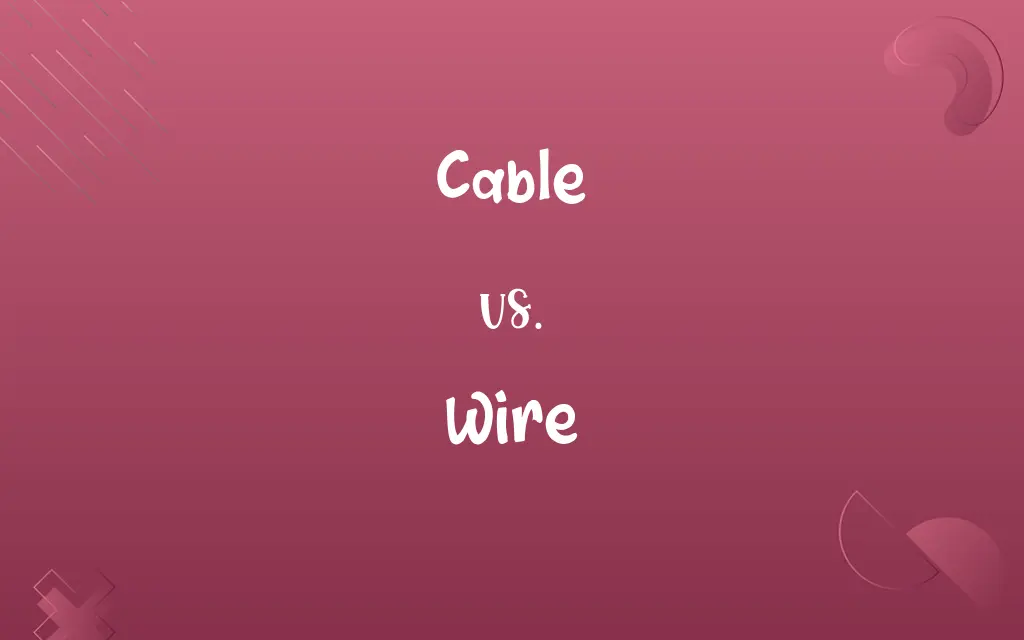Cable vs. Wire: Know the Difference

By Dua Fatima & Shumaila Saeed || Published on July 29, 2024
Cable is a collection of wires encased in sheathing, used for transmitting power or data. Wire is a single conductor, typically made of metal, for electricity or communication.

Key Differences
Cables and wires are fundamental components in electrical and communication systems, serving to conduct electricity or signals. While both are conductors, their construction and applications set them apart. Cables consist of multiple wires bundled together, often shielded with insulation, making them suitable for transmitting power or data across distances. Wires, in contrast, are single conductors that can be used alone or as part of a cable, focusing on basic electrical connections and simpler tasks.
Shumaila Saeed
Jul 29, 2024
The physical structure of cables allows for the transport of electricity or data signals in a secure and efficient manner, often protected by an outer layer that enhances durability and reduces interference. Wires, being singular conductors, lack this complexity and protection but offer flexibility and ease of use for specific applications, such as in circuits or for grounding purposes.
Dua Fatima
Jul 29, 2024
Cables are preferred in settings requiring robustness and the ability to carry signals or power over longer distances without significant loss. This includes networking, telecommunications, and power distribution. Wires, due to their simplicity, are more suited to internal circuitry, electronic devices, and as components within larger cables.
Shumaila Saeed
Jul 29, 2024
The choice between cable and wire depends on the specific needs of a project, including factors like signal integrity, environmental exposure, and physical constraints. Cables, with their multiple conductors and protective sheathing, are ideal for complex installations, whereas wires offer simplicity and versatility for straightforward electrical tasks.
Dua Fatima
Jul 29, 2024
Understanding the distinction between cables and wires is crucial for selecting the appropriate option for any given electrical or communication task. This choice impacts the efficiency, safety, and performance of the system, highlighting the importance of considering both the physical and functional differences.
Hifza Nasir
Jul 29, 2024
ADVERTISEMENT
Comparison Chart
Composition
Multiple wires encased in protective sheathing.
Single conductor, often without sheathing.
Shumaila Saeed
Jul 29, 2024
Function
Used for transmitting power or data.
Used for electrical connections and signals.
Dua Fatima
Jul 29, 2024
Application
Networking, telecommunications, power distribution.
Circuits, grounding, internal connections.
Shumaila Saeed
Jul 29, 2024
Durability
Generally more durable due to sheathing.
Less durable, more exposed to elements.
Dua Fatima
Jul 29, 2024
Flexibility
Less flexible, designed for specific routes.
More flexible, can be easily manipulated.
Shumaila Saeed
Jul 29, 2024
ADVERTISEMENT
Cable and Wire Definitions
Cable
A bundle of wires encased in sheathing for electrical or data transmission.
The Ethernet cable connects the router to the computer.
Shumaila Saeed
Feb 28, 2024
Wire
Used for grounding to enhance safety in electrical systems.
The grounding wire is connected to the earth to prevent shocks.
Shumaila Saeed
Feb 28, 2024
Cable
Used for long-distance and high-strength applications.
The suspension bridge is supported by massive steel cables.
Hifza Nasir
Feb 28, 2024
Wire
A single conductor for electricity or signal transmission.
The electrician used a copper wire to complete the circuit.
Dua Fatima
Feb 28, 2024
Cable
Often insulated to prevent interference and damage.
The power cable's insulation was designed to withstand high voltages.
Dua Fatima
Feb 28, 2024
ADVERTISEMENT
Wire
Flexible and easy to manipulate for various applications.
The artist twisted the wire into intricate shapes for the sculpture.
Dua Fatima
Feb 28, 2024
Cable
Can include various types of conductors for different uses.
The cable in the audio system uses copper conductors for clarity.
Hifza Nasir
Feb 28, 2024
Wire
Can be bare or insulated depending on its use.
The insulated wire was chosen for safety in the residential wiring.
Dua Fatima
Feb 28, 2024
Cable
Designed to connect and power devices, buildings, and systems.
The submarine cable provides internet access across continents.
Dua Fatima
Feb 28, 2024
Wire
Essential for connecting components within devices.
The technician soldered the wire to the circuit board for the repair.
Dua Fatima
Feb 28, 2024
Wire
Metal that has been drawn out into a strand or rod, used chiefly for structural support, as in concrete, and for conducting electricity, when it is usually insulated with a rubber or plastic cladding
Bought some wire at the hardware store.
Dua Fatima
Feb 27, 2024
Wire
A strand or rod of such material, or a cable made of such strands twisted together.
Dua Fatima
Feb 27, 2024
Wire
To attach or connect with electrical wire or cable
Is the printer wired to the computer?.
Shumaila Saeed
Feb 27, 2024
Wire
To connect, embed, incorporate, or include (something) into (something else) by or as if by wires:
Shumaila Saeed
Feb 27, 2024
Cable
An assembly of two or more wires, used for electrical power or data circuits; one or more and/or the whole may be insulated.
Dua Fatima
Feb 27, 2024
Cable
A large, strong rope or chain, of considerable length, used to retain a vessel at anchor, and for other purposes. It is made of hemp, of steel wire, or of iron links.
Shumaila Saeed
Feb 27, 2024
Repeatedly Asked Queries
Why are wires used in electronic devices?
Wires are used in electronic devices for internal connections due to their flexibility and ability to conduct electricity or signals between components.
Dua Fatima
Jul 29, 2024
Are cables always insulated?
Most cables are insulated to protect the conductors from damage and to prevent electrical interference, but the type and level of insulation can vary.
Dua Fatima
Jul 29, 2024
What is the main difference between cable and wire?
The main difference is that a cable is a bundle of wires encased in sheathing, while a wire is a single conductor.
Shumaila Saeed
Jul 29, 2024
Can a cable contain only one wire?
Technically, a cable could contain only one wire, but it is generally understood to consist of multiple wires. A single wire in sheathing is often referred to as a "coaxial cable."
Dua Fatima
Jul 29, 2024
Why is flexibility important for wires?
Flexibility allows wires to be easily routed, twisted, and connected in various configurations, which is essential for installation and repair tasks.
Shumaila Saeed
Jul 29, 2024
How does sheathing improve a cable's durability?
Sheathing protects the internal wires from physical damage, environmental factors, and electrical interference, enhancing the cable's durability and lifespan.
Dua Fatima
Jul 29, 2024
Can wires be used instead of cables for transmitting data?
Wires can transmit data but are more suited for short distances or internal connections, whereas cables are designed for longer distances and external applications.
Dua Fatima
Jul 29, 2024
Can cables be used for grounding?
Yes, cables can be used for grounding, especially those designed with specific conductors for this purpose, to ensure safety and prevent electrical faults.
Shumaila Saeed
Jul 29, 2024
What types of materials are used to make cables and wires?
Common materials include copper, aluminum, and fiber optics for cables, and copper or aluminum for wires, chosen for their conductivity and durability.
Dua Fatima
Jul 29, 2024
How do environmental factors affect the choice between cable and wire?
Environmental factors, such as exposure to moisture, temperature extremes, and physical stress, influence the choice by dictating the need for durability and protection offered by cables.
Dua Fatima
Jul 29, 2024
How do data cables differ from power cables?
Data cables are designed to transmit signals with minimal interference, while power cables are made to carry electrical current with appropriate insulation for safety.
Dua Fatima
Jul 29, 2024
Why might a cable be preferred over a wire in industrial settings?
Cables are preferred for their enhanced durability, higher capacity for power or data transmission, and protection against environmental and electrical interference.
Shumaila Saeed
Jul 29, 2024
Is it possible to have a wireless connection that performs as well as a cable?
Wireless technologies continue to improve, but wired connections usually offer more reliable and faster data transmission for many applications.
Dua Fatima
Jul 29, 2024
What determines the conductivity of a wire?
The material (e.g., copper, aluminum), diameter, and length of the wire determine its conductivity and resistance to electrical flow.
Dua Fatima
Jul 29, 2024
How are cables and wires measured and classified?
They are measured by diameter, gauge (for wires), and type or category (for cables), which indicate their capacity, use, and the standards they meet.
Dua Fatima
Jul 29, 2024
Share this page
Link for your blog / website
HTML
Link to share via messenger
About Author
Written by
Dua FatimaCo-written by
Shumaila SaeedShumaila Saeed, an expert content creator with 6 years of experience, specializes in distilling complex topics into easily digestible comparisons, shining a light on the nuances that both inform and educate readers with clarity and accuracy.









































































